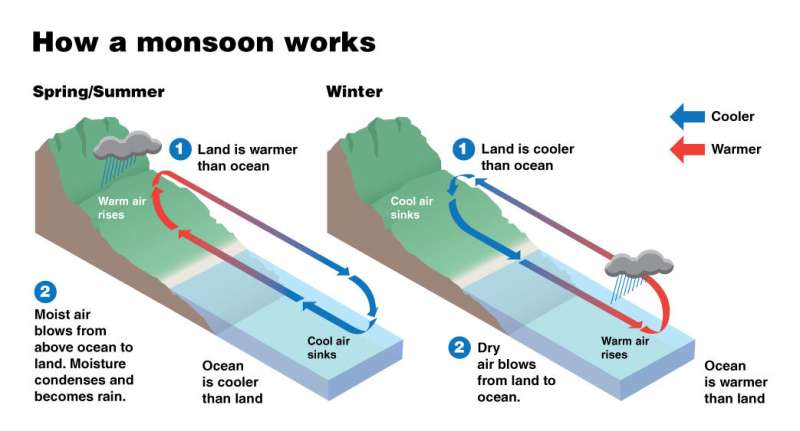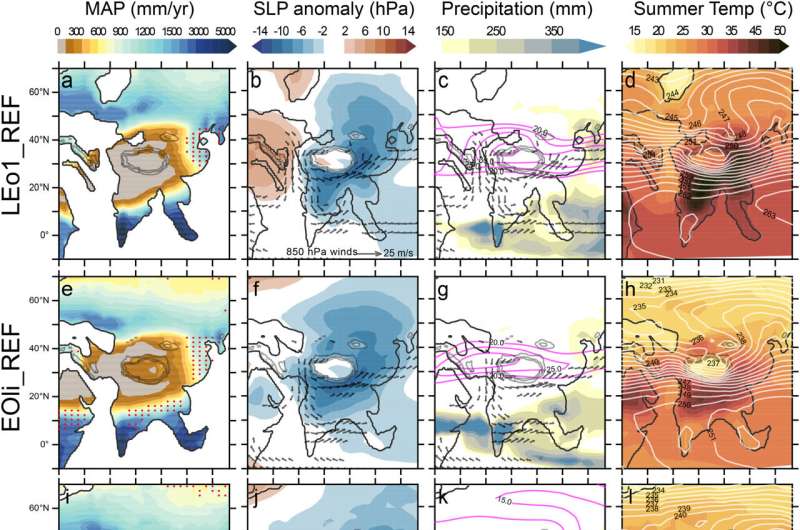June 19, 2023 feature
This article has been reviewed according to Science X's editorial process and policies. Editors have highlighted the following attributes while ensuring the content's credibility:
fact-checked
trusted source
proofread
Climate modeling suggests monsoon origination up to 40 million years ago

Monsoons are seasonal climate conditions resulting from changes in wind that bring extreme drought or rain, depending upon the time of year. Those occurring in south Asia and east Asia are affected by a combination of atmospheric and oceanographic conditions. The Asian and African mountain belts in the area also impact monsoon formation. Today, monsoons support local livelihoods by providing rain to sustain harvests, but they also bring devastating droughts and floods that damage infrastructure and threaten life.
This annual phenomenon occurs due to the difference in temperature between the land and the surrounding oceans. In summer, the land warms faster than the water, causing moist air to rise over the land where it condenses and falls as rain. In winter the opposite is true, where cool dry air blows from the land out to the ocean, leading to more arid conditions on the continent.
New research by scientists at Aix Marseille University, France, and their collaborators, reported in Earth-Science Reviews, suggests seasonal Asian monsoon conditions were established back in the Paleogene (66 million to 23 million years ago), a period that experienced extreme climate warming events. The researchers conducted summary analyses of 20 paleoclimate simulations across the late Eocene through to the late Miocene (approximately 40 million to 8 million years ago) and found that the uplift and creation of a number of mountain ranges through the millennia have resulted in the South Asian monsoon patterns we see today. These include the East African and Anatolian-Iranian mountain ranges as well as the Arabian Peninsula.
The presence of wind-blown dust in northeast Tibet as well as the preservation of paleobotanical indicators in Myanmar and China, such as fossil flowers and the chemical composition of mammal tooth enamel and gastropod shells, all point to this earlier evolution of monsoonal climate beginning in the late Eocene, 20 million years sooner than previously thought.
This is further supported by the changing climate observed in the Yunnan region of southwest China in which coal layers dated to the same time suggest an expansion of humid swamp conditions. At the same time, continental areas of Asia experienced a transition to drier and more arid conditions as an inland sea, the Paratethys Sea, began to retreat. This is known from fossil pollen found within the rock layers that have been identified with xerophytic plants, these being adapted to dry conditions and able to store water, such as succulents and cacti.

Over millions of years, this seasonal aridification and excessive moisture progressed into discrete summer and winter events that can be identified with certainty in the Neogene (beginning 23 million years ago) until the present day. Among a host of evidence, including increased clay weathering, the conspicuous disappearance of the plant Metasequoia from the Yunnan region (with its living relatives being intolerant of dry winters) and a progressive change in vegetation from evergreen to deciduous and then to grasslands (in places like Nepal, India and Pakistan), there is clear indication of more severe dry and wet seasons being experienced.
Modeling by the researchers and previous studies found a consensus that the retreat of the Paratethys Sea and/or global sea level fall in the late Paleogene and early Neogene led to increased moisture circulation during summer months. However, the height of surrounding mountain belts or other landforms, such as arid dust plateaus, impacted continentality (the difference between terrestrial and marine climates) and therefore the intensity of the historical monsoons modeled.
In the late Eocene, the models suggest an arid region spread at a rate of approximately 500 mm per year outward from northern India, while in southern India there were high levels of annual rainfall, suggested to have exceeded 3,000 mm per year (similar to modern annual rainfall measurements). The aridity then progressively spread to Arabia and northern Africa, shifting the wet climatic belt further into southern Asia. As the surrounding mountain belt continued to build, the modeling suggests each uplift event caused a 4 to 5 degree latitudinal shift north of the monsoon belt into China and Japan.
While monsoons are both an ever-present hazard and benefit of modern atmospheric and oceanic systems, their progressive development over millions of years means that there will continue to be changes in these phenomena over the millennia to come.
More information: D. Tardif et al, The role of paleogeography in Asian monsoon evolution: a review and new insights from climate modelling, Earth-Science Reviews (2023). DOI: 10.1016/j.earscirev.2023.104464
© 2023 Science X Network




















